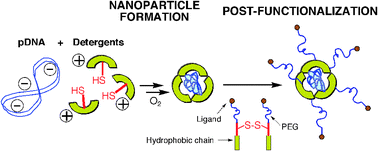Formulation of PEG–folic acid coated nanometric DNA particles from perfluoroalkylated cationic dimerizable detergents and in vitro folate-targeted intracellular delivery
Abstract
Present attempts in

* Corresponding authors
a
Laboratoire de Chimie des Molécules Bioactives et des Arômes, UMR 6001, Université de Nice Sophia-Antipolis, CNRS, Institut de Chimie de Nice, 28, avenue de Valrose, Nice Cédex 2, France
E-mail:
vierling@unice.fr
Fax: 33(0)49207651
Tel: 33(0)492076143
Present attempts in

 Please wait while we load your content...
Something went wrong. Try again?
Please wait while we load your content...
Something went wrong. Try again?
L. Le Gourriérec, C. Di Giorgio, J. Greiner and P. Vierling, New J. Chem., 2008, 32, 2027 DOI: 10.1039/B806043F
To request permission to reproduce material from this article, please go to the Copyright Clearance Center request page.
If you are an author contributing to an RSC publication, you do not need to request permission provided correct acknowledgement is given.
If you are the author of this article, you do not need to request permission to reproduce figures and diagrams provided correct acknowledgement is given. If you want to reproduce the whole article in a third-party publication (excluding your thesis/dissertation for which permission is not required) please go to the Copyright Clearance Center request page.
Read more about how to correctly acknowledge RSC content.
 Fetching data from CrossRef.
Fetching data from CrossRef.
This may take some time to load.
Loading related content
